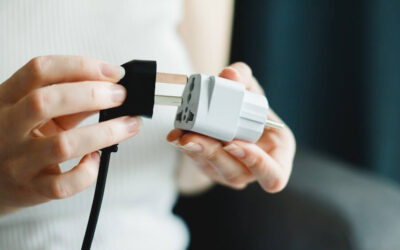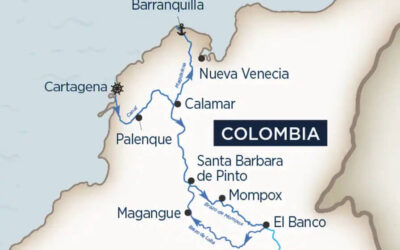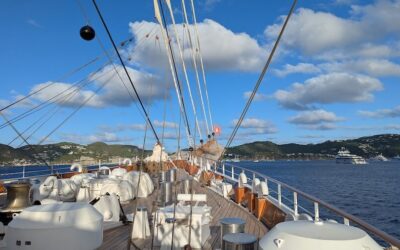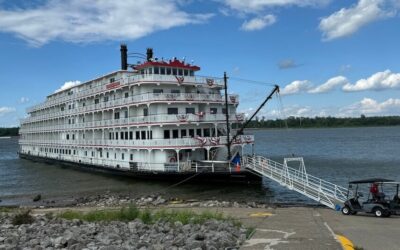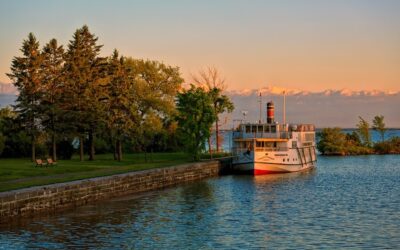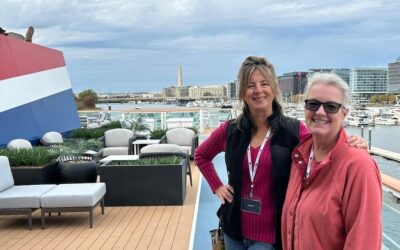By Stephanie Sack
Stretching from the Canal du Midi in the south to the Canal du Nivernais in the north, the complex canal systems crisscrossing France are not just inland waterways — they are living artifacts of European history, once crucial for trade and industry and now preserved for tourism, leisure, and cultural heritage.
Weaving through small towns, boutique vineyards, and unspoiled countryside, these canals carry the echoes of France’s past while offering modern travelers a glimpse into a slower, more relaxed way of life.
Here’s an overview of the best canals in France for barge cruising, including some history on their origins and pros (and cons) of each one.
The History of France’s Canals
The idea of canal-building in France dates back to the Romans, who were masters of their craft when it came to designing, building, and maintaining sophisticated irrigation systems.
Some of the earliest inland waterways were built between first century BCE and the third century CE in what is now Provence and Languedoc, then Roman colonies, as part of their extensive water management infrastructure.
17th Century France — The Golden Era for Canal Building
It was, however, the 17th century that proved to be the golden era of France’s canal building, as King Henri IV of the late 16th century and his advisor, Maximilien de Béthune, the Duke of Sully, began the initial efforts of these grand projects.
In 1643, the Canal de Briare was the first significant inland waterway, connecting the Loire and Seine Rivers. Inspired by the commercial applications of transporting goods, produce, and timber to Paris, in 1861 under Louis XIV the famed engineer Pierre-Paul Riquet built the Canal du Midi, an engineering marvel linking the Atlantic to the Mediterranean.
By the19th century, Napoleon and later rulers expanded the national canal network to improve commerce, with major canals like the Canal de Bourgogne, Canal de l’Aisne à la Marne, and Canal du Nivernais connecting key trade centers to transport wine, grain, coal, and textiles, fueling France’s economic growth and, therefore, the country’s international position of power.
Big Canals
Big canals in France are the heavy lifters of the waterway world — think Canal du Rhône à Sète and Canal de la Marne au Rhin. These aren’t your dainty pleasure routes; they’re built for serious barge traffic. Lined with industrial infrastructure, they sometimes feel more like engineered highways than quaint canals, especially when they trace or replace natural waterways.
They tend to be straight-shooters — literally — with long, linear stretches that sometimes run right alongside or even replace rivers.
To overcome the unpredictability of river travel, canals were purposefully engineered to avoid dangerous rapids and hazardous sandbanks; by offering safer navigation, consistent water levels, and more efficient routes, canals ensured the reliable transport of goods across France.
With their expansive size and man-managed route, these larger canals serve as busy barging boulevards rather than sweet little side streets, but there’s something truly breathtaking about their scale and purpose. You’ll also find these massive industrial “highway” canals in the Netherlands.
Small Canals
On the flip side, smaller canals are the charmers of the French waterways — think Canal du Nivernais, Canal de Briare, and the storybook Canal de Bourgogne. These narrow, winding gems were built for smaller barges back in the day, and they’ve kept their cozy character ever since. And thus these are the best canals in France for holiday barge cruising.
With tree-lined towpaths, flower-draped lockhouses, and adorable villages tucked between family-owned vineyards, they feel like something out of a watercolor painting. Perfect for lazy cruising, leisurely biking, or simply soaking in the scenery, these canals aren’t about speed; rather, they’re about savoring.
Steeped in history and overflowing with ambiance, these signature inland waterways are where the peaceful pace of French barge cruising truly shines.
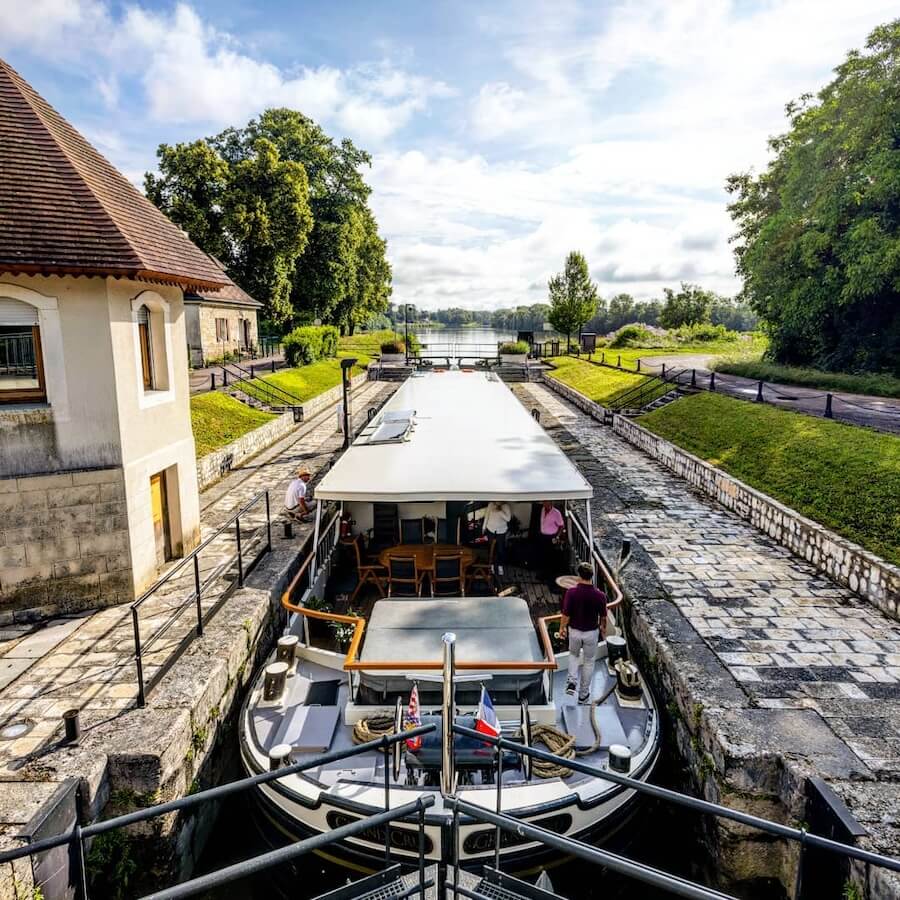
Just what are locks exactly?
Locks are the ingenious staircases of the canal world, helping boats move up or down as the landscape changes elevation. Found all along France’s waterways, these chambers fill or empty with water to raise or lower a barge from one level to another — like an aquatic elevator!
Many were built centuries ago and remain beautifully preserved, with some like those dotting the Canal de Bourgogne and the Canal du Centre still operated the traditional way: hand-cranked by a lockkeeper.
Others, such as the locks on the Canal de Garonne, have been modernized with electric mechanisms, but the process is still mesmerizing to watch, or, even better, experience firsthand. Gliding into a lock, feeling the water shift around you, and rising or sinking as the brilliantly engineered gates creak open… it’s like time travel on water.
VIDEO: See a French canal lock in action below!
Who Built France’s Canals?
Built by thousands of manual laborers known as “ouvriers” (workers), many of whom came from poor rural backgrounds, the French canals owe their existence and longevity to the many men who undertook the backbreaking labor. These workers included seasonal laborers who accepted canal construction jobs during periods when they were not farming, as they were often desperate for income.
Some canals, in particular the Canal du Midi, used forced labor, including prisoners from local jails. Of course, every canal also had its own team of skilled tradesmen to build the locks, bridges, and aqueducts, as they brought crucial knowledge of masonry and engineering.
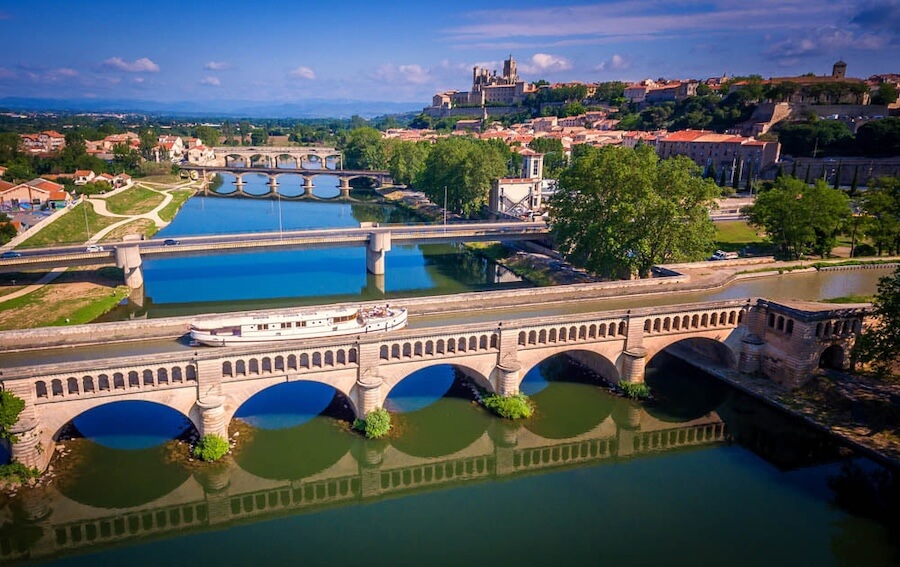
The Evolution of Transportation — Trains & Automobiles
By the 20th century, the technological advancements of the Industrial Revolution led to the rise of railways and automobiles, contributing to the decline of canal freight transport.
Many of these once-crucial canals were outright abandoned and fell into disrepair. By the time the 1970s rolled around, it was obvious the French canal system required significant investment for modernization and maintenance. While exact figures vary, estimates suggest that hundreds of millions of francs were needed for the immense scope of the restoration.
Interestingly, a handful of canals were deemed too expensive to upgrade for freight and were instead repurposed for leisure boating, which required less investment than full modernization…et voila! That’s how we got what we now know as our living canal system in France!
Today, the canals of France primarily serve as a major tourist destination for barge cruises and other small ships, offering a unique way to experience the historical significance of these beautifully preserved waterways.
RELATED: Canal Barging Tips: Is a Canal Barge Right For You?
The 5 Best Canals in France for Barge Cruising
- Canal de Bourgogne (Northern and Southern Burgundy region)
- Canal du Nivernais (Northern Burgundy region)
- Canal du Midi (Languedoc region)
- Canal du Centre (Southern Burgundy region)
- Canal de l’Aisne à la Marne (Champagne region)
Although France is home to over 100 canals and navigable rivers, when it comes to barge cruise traffic — especially the kind geared toward leisure and tourism — around 25 to 30 main canals and rivers regularly see this kind of activity.
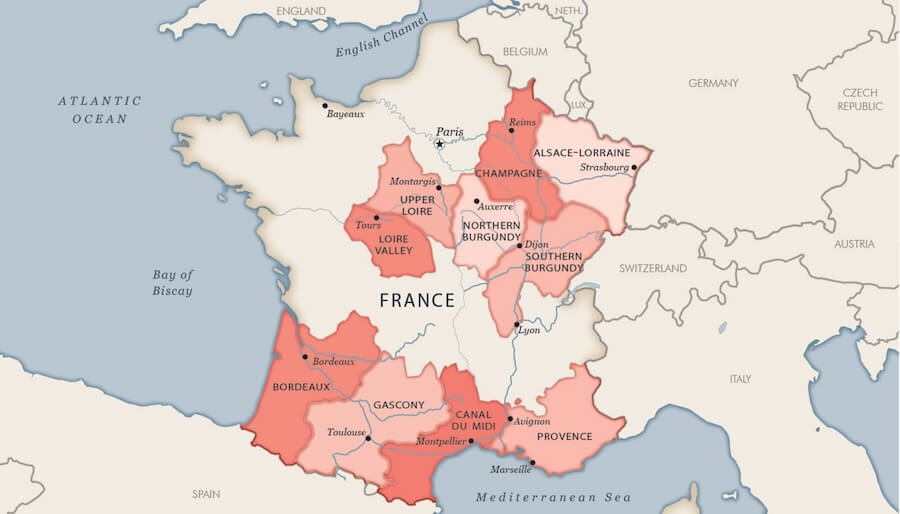
Within these two dozen or so inland waterways, a select group of exceptionally scenic canals host most of the dreamy barge cruises travelers fall in love with.
Here are five of these most popular and best French canals for small ships, including luxury barge cruises:
1. Canal Cruising on Canal de Bourgogne
In the mid-17th century, Pierre Paul Riquet, the renowned chief engineer of the Canal du Midi, envisioned an ambitious waterway that would facilitate inland navigation across France, improving trade and economic development.
Riquet proposed a route for what would later become the Canal de Bourgogne, aiming to connect the Seine and Rhône River basins, creating a vital transport link between northern and southern France.
However, despite his success with the Canal du Midi, Riquet’s proposed design for this new canal was rejected as too costly and impractical at the time.
Decades later, in 1696, the esteemed military engineer Sébastien Le Prestre de Vauban revisited the idea, recognizing the strategic and commercial advantages of such a canal; it was, however, only in 1777, under the reign of King Louis XVI, that work on the waterway finally commenced.
By 1793, an unfortunate combination of dwindling funds and structural issues had brought the canal’s progress to a standstill; the advent of the French Revolution and the subsequent Napoleonic Wars further delayed the project, as resources were diverted to more pressing national concerns.
Nevertheless, the regional government of Burgundy remained determined to see the canal completed, pressing ahead with the eastern segment. After years of effort, the first completed section of the canal — stretching between the city of Dijon and the River Saône — was finally opened to navigation. Despite the support of Emperor Napoleon, financial instability and technical challenges continued to plague the project, leading to repeated delays.
The completion of the full canal in 1832 remained a drawn-out endeavor, requiring extensive resources and political will to overcome the difficulties posed by construction and funding.
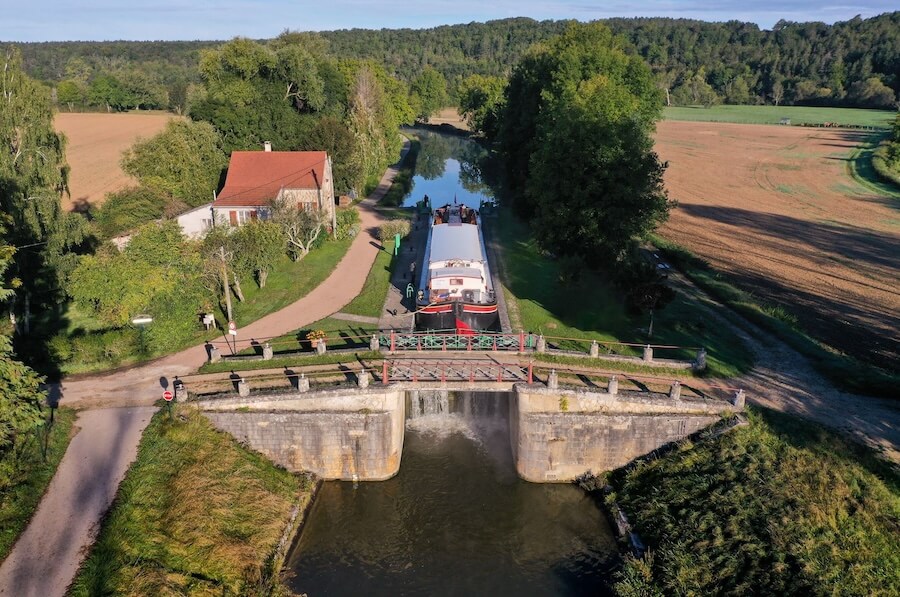
Cruising the Canal de Bourgogne is like gliding through the very heart of Burgundy’s soul. Wine lovers rejoice — this canal winds past legendary Grand Cru and Premier Cru vineyards, where you can sip world-class Pinot Noir and Chardonnay just steps from where the grapes grow.
Cycling enthusiasts are equally spoiled: a dedicated towpath runs alongside much of the canal, perfect for scenic rides through sunflower fields, stone villages, and rolling hills. Add in historic châteaux, gourmet cuisine, and postcard-perfect locks, and you’ve got a cruise that’s equal parts elegant, active, and indulgently French.
Today, the Canal de Bourgogne gently winds through the heart of Burgundy’s most prestigious Grand Cru and Premier Cru vineyards, ensuring guests who travel along this canal are intimately introduced to the rarefied world of French wine, so they should come thirsty!
Oenophiles especially are in for a treat, as tastings at renowned appellations such as Nuits-St-Georges, Pommard, and Puligny-Montrachet spotlight the region’s signature elixirs, while tours of private estates showcase the pampered grapes of Burgundy’s family-owned vineyards.
Finally, miles and miles of manicured towpath, dotted with active locals and adorable lockhouses, make the Canal de Bourgogne one of the most biking-friendly cruise routes as well.
Canal de Bourgogne: Caveats
As with all of France’s living canals, the Canal de Bourgogne’s locks, moorings, and harbors require ongoing restoration and repair. The most traversed sections of the canal are currently scheduled to undergo masonry projects and structural upgrades, aiming to reduce water leakage through strengthening banks using techniques such as sheet piling and bioengineering.
In keeping with these continuing efforts at modernization, sections between Saint-Jean-de-Losne and Venarey-Les Laumes will be equipped with fiber optics, preparing for future automation of locks and hydraulic structures. A centralized control center, based in Dijon and operational by 2027, will also enable remote management of the facilities. This project is part of a comprehensive approach aimed at optimizing the use of water resources while improving the services offered to users.
Accordingly, only a handful of barges are departing the Canal de Bourgogne in 2026, electing to cruise a more northerly section, or sailing the neighboring Canal de Centre to the south.
With this massive project underway as of late 2024/early 2025, it’s safe to say the Canal de Bourgogne’s nips and tucks will happen through the 2026 barging season and most likely into 2027.
Hub City for Canal de Bourgogne Cruises: Paris
That said, some of vessels can arrange for pickup and drop off in Dijon or Geneva, in luie of Paris, depending on the details of the booking and composition of the party.
2. Barge Cruising on Canal du Nivernais
With breathtaking vistas, lush pastures, and gorgeous foliage, the Canal du Nivernais is cited often as one of France’s most picturesque waterways.
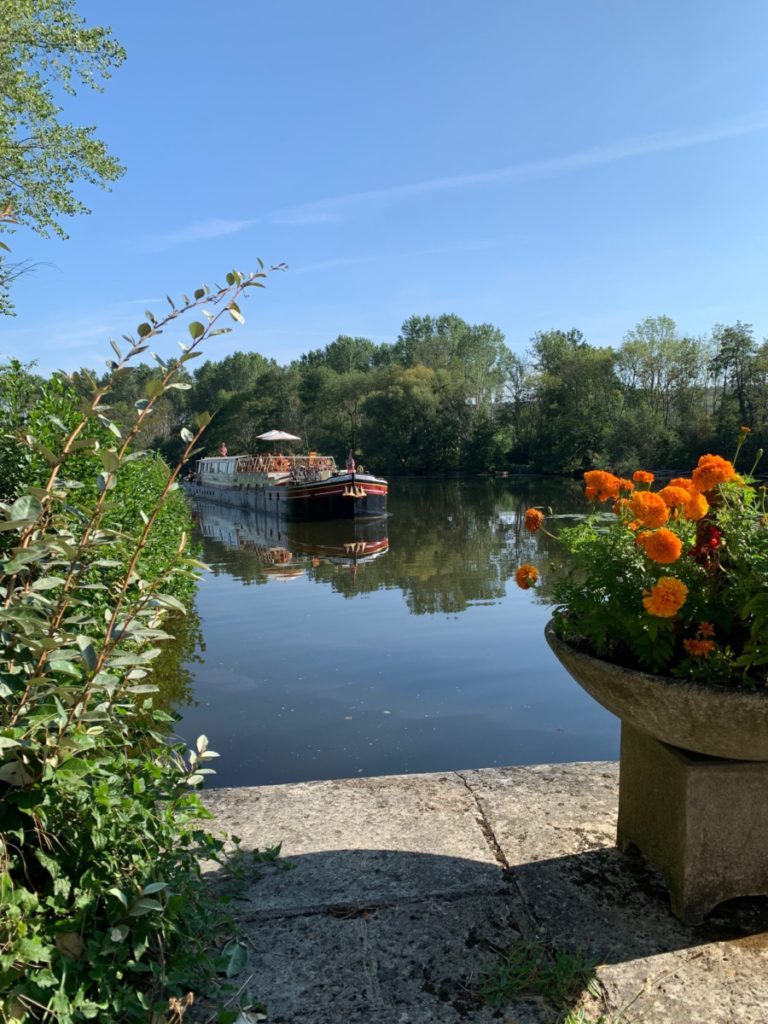
Conceived in the late 18th century, its main purpose was the transportation of timber from the dense forests of the Morvan to Paris via the River Yonne.
Prior to its construction, timber was floated downstream on the Yonne, but growing demands for a more efficient transport method led to the ambitious project of creating a canal that would connect the Loire and Seine River basins.
Work on the canal began in 1784, under the reign of King Louis XVI, with the aim of providing a direct navigable link between the Loire at Decize and the Yonne at Auxerre. However, much like many grand infrastructure projects of the era, the Canal du Nivernais faced significant delays due to the turmoil of the French Revolution and subsequent financial constraints. Despite these challenges, construction continued sporadically over the years, with different sections opening progressively.
The canal was finally completed in 1843, allowing barges to transport timber, and, eventually, goods and produce between northern and central France with greater ease.
Cruising the Canal du Nivernais is like slipping into a slow, luxurious dream — welcoming, pleasurable, and impossibly scenic. Picture yourself gliding through a living watercolor, with mirror-like waters, gorgeous golden sunsets, and vine-draped landscapes around every bend.
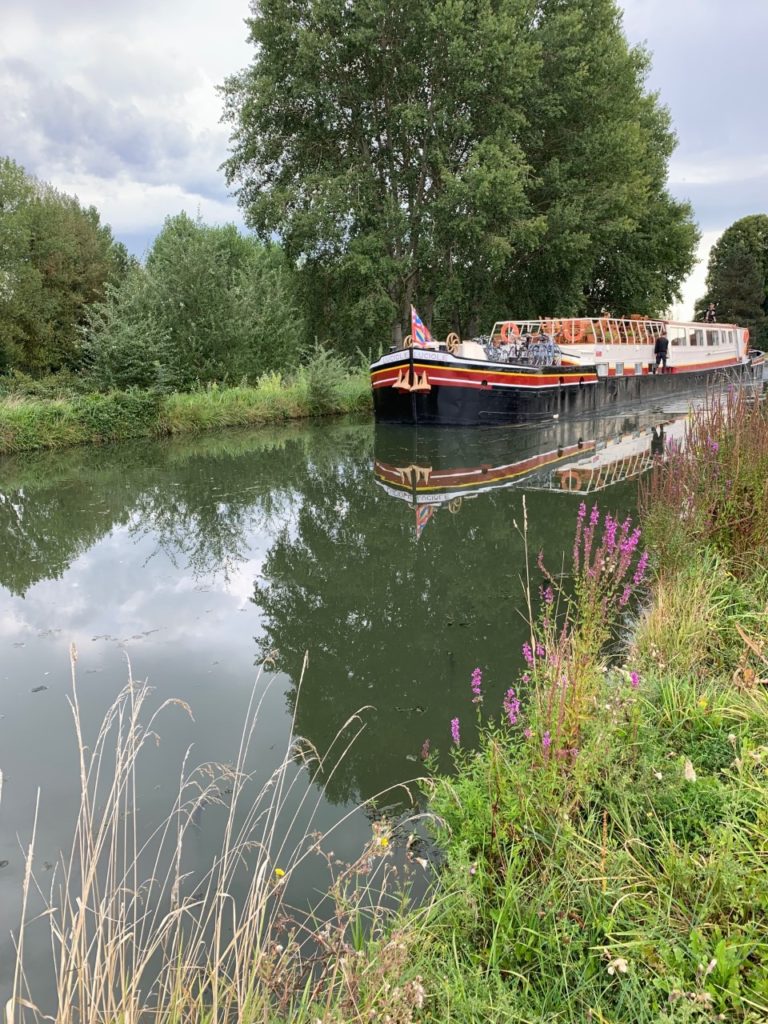
Oneophiles are especially thrilled to discover Burgundy’s exceptional elixirs, indulging in private tastings in small, centuries-old cellars and sipping the region’s crisp Chablis and Chardonnay at lunches and dinners onboard.
Active guests can hop on a bike and follow the region’s beautifully manicured towpaths to tiny moorings and charming villages. It’s leisure, elevated — with just the right touch of Burgundian whimsy.

The home of France’s Chardonnay grapes and Chablis wines, the terroir along the Canal du Nivernais infuses the fruit with a flavor profile of flint and citrus, reflecting the soil’s rocky sediment — perfect to pair with the region’s tangy Dôme de Vézelay goat cheese.
A daily itinerary of activities ashore includes a visit to Auxerre, where visitors can marvel at the restored riverfront marina brought back to vivid life by the eye-catching pleasure craft mooring there.

For active travelers, the canal’s beautifully refurbished towpath ensures the Canal du Nivernais is one of the top-rated routes for leisurely cycling from lock to lock.
RELATED: Heidi reviews cruising the Canal du Nivernais on the 12-pax Barge Luciole.
Canal du Nivernais: Caveats
While the Canal du Nivernais is beloved for its beauty, water levels in the canal can fluctuate, especially in dry seasons, which occasionally affects navigation. Also, while the region is delightfully unspoiled, it’s also quite sleepy, so don’t expect big cities or lively nightlife, as this cruise is all about unplugging.
Hub City for Nivernais Canal Cruises: Paris
The main hub is Paris, though some vessels can arrange for pickup and drop off in Dijon, depending on the details of the booking and composition of the party.
3. Barge Cruising on Canal du Midi
The Canal du Midi, one of the greatest feats of 17th-century engineering, was envisioned by Pierre-Paul Riquet to connect the Atlantic Ocean to the Mediterranean Sea, bypassing the lengthy and perilous maritime route around Spain.
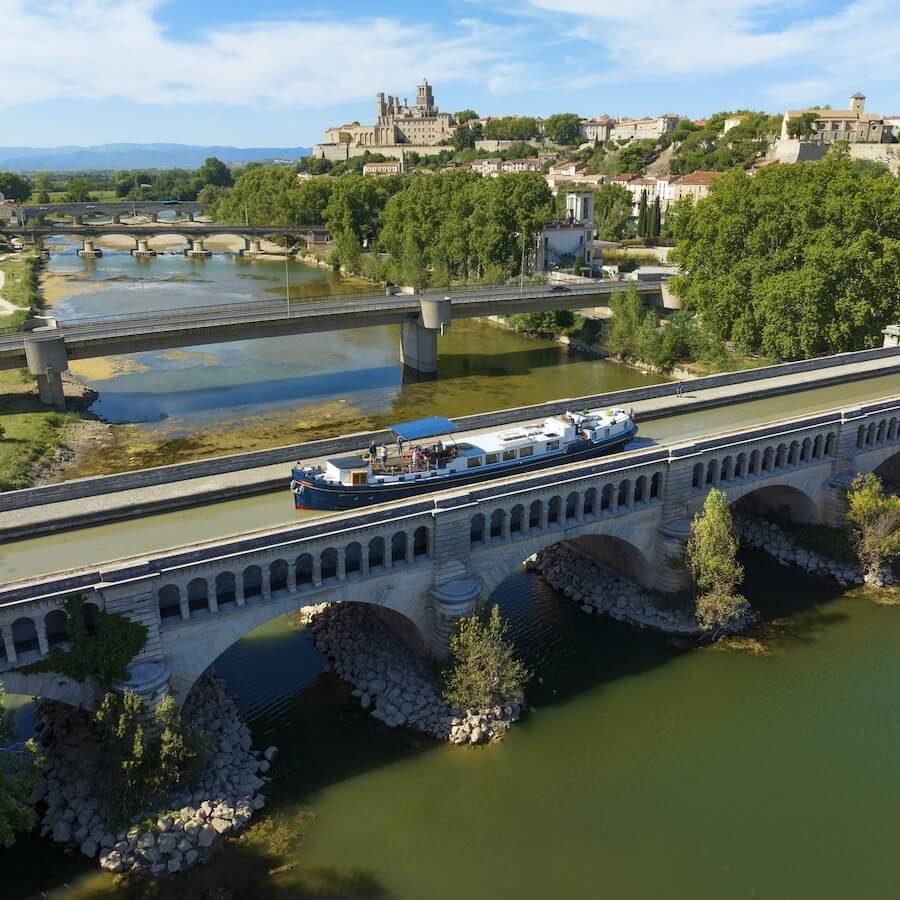
Riquet, a visionary tax collector from Languedoc, proposed a grand waterway linking the Garonne River near Toulouse to the Étang de Thau on the Mediterranean coast, creating an inland trade route designed to bolster economic growth in southern France.
Work on the canal began in 1666, with Riquet personally overseeing the project. Despite the immense technical challenges, including the need to supply water to the canal’s highest point at the Seuil de Naurouze, Riquet devised an innovative system of reservoirs and feeder canals — many of which are still in use today. Thousands of laborers worked tirelessly to carve the canal through the landscape, constructing locks, aqueducts, and tunnels.
Tragically, Riquet passed away in 1680, just months before his life’s work was completed. Nevertheless, the Canal du Midi was officially inaugurated in 1681, quickly revolutionizing trade and transport in the region. The canal facilitated the movement of grain, wine, and textiles, strengthening commercial ties between France’s inland cities and the Mediterranean coast.
In 1996 the canal found a new life as a UNESCO World Heritage Site, celebrated, and, most crucially, protected due to its immense historical significance.
Today, the region surrounding the Canal du Midi is famed for its astonishing Roman ruins, many of which are visited by guests on barge cruises.
Highlights include the UNESCO-listed city of Carcassonne, where Rome ruled until the 5th century, and also Narbonne, where guests can walk on the stones of the Via Domita, the first Roman road built to link Italy to Southern France!
The canal’s many surrounding vineyards produce a variety of wines through a medley of methods, a significant handful of them using newer vinification systems and biodynamic fermentation processes. Though less famous than Burgundy, the Languedoc is bursting with a new generation of vitners crafting loamy reds, flinty whites, and up-and-coming organic appellations just waiting to be discovered.
The Canal du Midi winds gracefully through the sun-soaked landscapes of Southern France, where arched stone bridges, tree-lined towpaths, and centuries-old locks set a historic stage.
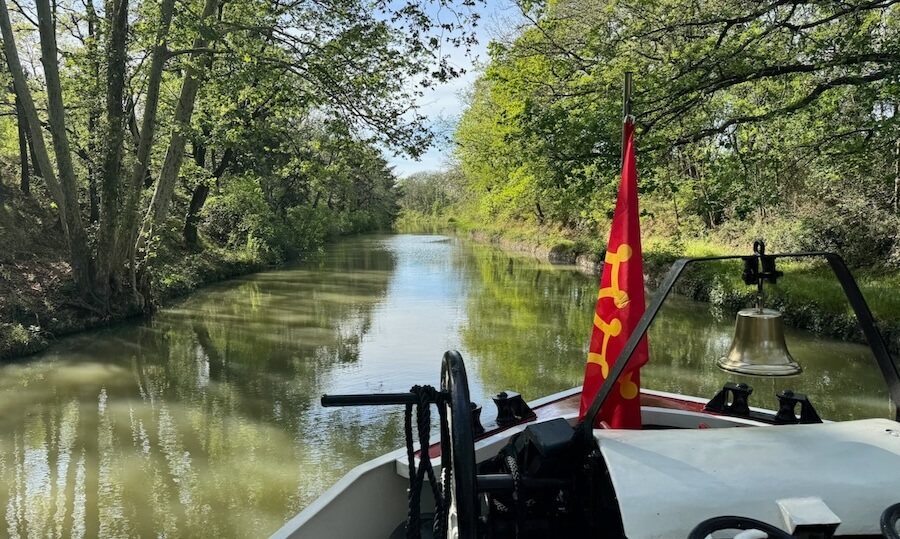
Canal du Midi: Caveats
With so many options for boating and barging in the South of France, the Canal du Midi is incredibly popular in summer, especially around hotspots such as Carcassonne and Le Somail. Thanks to a preponderance of vessels ranging from self-drive pontoons to luxurious yachts, guests should anticipate more traffic on the water, which could mean crowded moorings and waiting times at locks.
Another factor to consider is that the tens of thousands of plane trees that once shaded the canal have sadly been cut down. While this has been done to eradicate a waterborne virus and extensive replanting is underway, sections of the canal can now feel exposed.
Hub Cities for Canal du Midi Cruises: Paris, Provence or Bordeaux
Easily accessible by train from Paris or Barcelona, and within driving distance from Provence or Bordeaux, barges on the Canal du Midi are confidently recommended for those who wish to enjoy intra-European travels either before or after their cruise.
RELATED: Karl Zimmermann Reviews the Roi Soleil Barge on Canal du Midi.
RELATED: Peter Knego Reviews the Athos Barge Cruising Canal du Midi.
RELATED: A First Timer Reviews a Canal du Midi Barge Cruise Aboard Esperance.
4. Cruising on the Canal du Centre
A key waterway in central France, the Canal du Centre was originally constructed to connect the Loire and Saône Rivers, providing an essential link between France’s Atlantic and Mediterranean coasts.
Built at a blinding pace over only 10 years during the late 18th century, the Canal du Centre was one of the first canals in France to use pound locks, making it a major advancement in inland navigation.
Work on the canal began in 1783 under the direction of engineer Émiland Gauthey, during the reign of King Louis XVI. Due to the region’s undulating topography, the canal’s design had to overcome significant elevation changes, leading to the construction of a whopping 61 locks along its 70-mile route!
Officially opening in 1792, it became a vital boulevard for transporting coal, wine, grain, and other goods, significantly contributing to France’s industrial and commercial expansion.
Throughout the 19th century, the canal was an essential artery for Burgundy’s famed wine trade, allowing barrels of prestigious vintages to travel efficiently toward markets in Paris and beyond.
Given its favorable geography connecting the north and south of France, the Canal du Centre also played a strategic role during the Napoleonic era; recognizing the canal’s military and logistical importance, Napoleon relied on it particularly to facilitate the rapid movement of troops, supplies, and artillery, allowing the French military to bypass the more vulnerable coastal routes.
Winding through the heart of southern Burgundy, the Canal du Centre offers a relaxed voyage through one of France’s most iconic wine regions. Float past vineyards producing world-renowned Pinot Noir and Chardonnay, with opportunities to swirl, sip, and savor at tasting rooms and private cellars throughout Mercurey, Rully, and Givry.
The scenery is pastoral perfection — think tiled-roof villages, locals strolling and cycling the towpaths, and elegant stonework preserved on the canal’s many bridges. For guests looking for a canal cruise combining top-tier wine and tranquil countryside, the Canal du Centre is a barging bullseye!
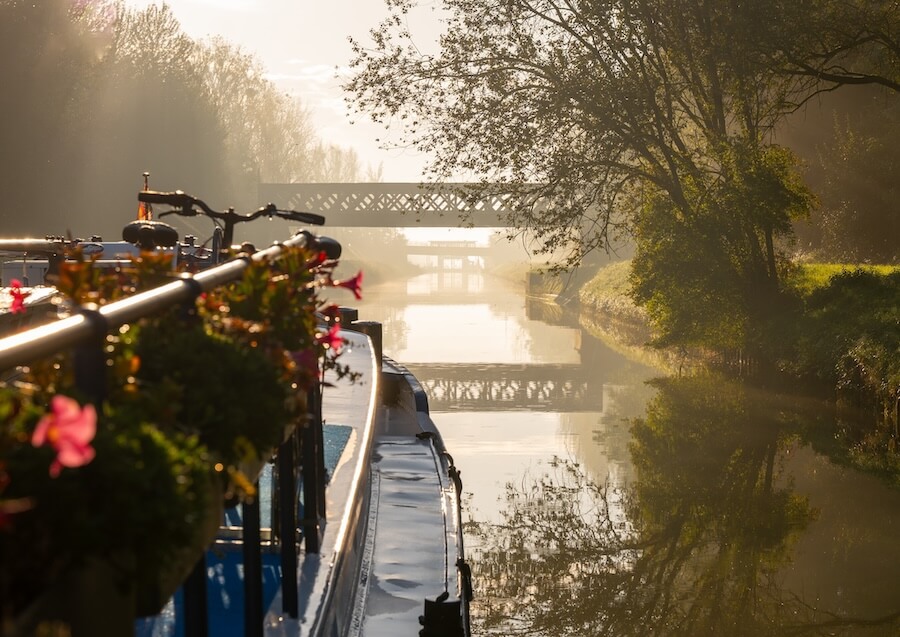
Recognized today for its scenic beauty and valuable patrimony, the Canal du Centre is a beloved destination for pleasure cruises, leisurely cycling, and walking tours. Visitors can glide past rolling vineyards, charming villages, and ancient stone bridges, while exploring the lively markets and small museums of historic port towns such as Chalon-sur-Saône.
Though not a UNESCO site itself, the Canal du Centre gently snakes through Southern Burgundy’s fertile terroir, which is home to the Climats of Burgundy, a UNESCO-listed vineyard landscape.
Canal du Centre: Caveats
The Canal du Centre links the Loire and Saône rivers, passing through both charming wine villages and more industrial zones near towns such as Chalon-sur-Saône. Not every stretch is picture-perfect, though going through the massive lock linking the canal to the river is extraordinary and the cruise route’s scenic parts through wine villages and lovely woodlands are quite scenic.
As the Canal du Centre is an emerging route, tourist amenities are not as developed as other, more celebrated inland waterways. That means fewer crowds, but also fewer attractions. For some, that’s a perk; for others, it may feel a bit “quieter” than more established barge cruising routes.
Hub City for Canal du Centre Cruises: Paris
Along this route, Paris is the hub city for the barges, although some of the vessels can arrange for pickup and drop off in Dijon, depending on the details of the booking and composition of the party.
Water Levels on French Canals
On French canals, water levels can fluctuate, especially during unusually dry summers or after heavy rains. While these issues are not typically as dramatic as those that are associated with Europe’s major rivers, canals can still be affected; some sections may impose navigation limits or temporary closures when water is too low or locks need repair.
That said, because most canals are manmade and managed with reservoirs, they tend to be more stable and predictable than tourism-heavy waterways such as the Rhône or Rhine
5. Canal de l’Aisne à la Marne
A crucial link between the River Aisne and the River Marne, the Canal dr l’Aisne a la Marne weaves through the heart of the Champagne region. With construction beginning in in 1841 and completion in 1866, the canal played an essential role in trade and industry, connecting northern and eastern France while providing in inland avenue for transport of goods such as timber, coal, grain, and, of course, Champagne’s signature sparkling wine.
The canal passes through important champagne-producing areas, particularly around Reims, one of the region’s most celebrated centers. Both established and emerging vineyards lining the canal belong to prestigious Champagne appellations such as Montagne de Reims and Vallée de la Marne.
Of course, no one who travels along the Canal de l’Aisne à la Marne can miss Champagne samplings, so tours and tastings at houses such as Veuve Clicquot, Taittinger, Ruinart, and Pommery ensure guests can taste the stars!
However, the canal’s history is deeply intertwined with the military conflicts that shaped the region; more than just an inland waterway for goods and wood, it is a silent witness to some of the most devastating battles of World War I.
As a strategic link between the Aisne and Marne rivers, the canal and its surroundings became a frontline battleground, particularly during the pivotal Aisne-Marne offensives of 1918. By the end of the war, the Canal de l’Aisne à la Marne’s locks, bridges, and moorings were completely devastated.
Entirely restored and rebuilt through the 1940s and early 1950s, Canal de l’Aisne à la Marne symbolizes the resilience of the region and its commitment to restoring vital infrastructure.
Indeed, the images of luxury vessels gliding along the peaceful waters of the Canal de l’Aisne à la Marne contrast starkly with its wartime past. Many sites along its route, including war memorials and battlefields, serve as reminders of the conflict.
The nearby Champagne battlefields and cemeteries pay tribute to the thousands of soldiers who fought and died in the region. Reims, heavily damaged in the war, has since been restored, and visitors cruising the canal can explore its famous Notre-Dame de Reims Cathedral, which was once targeted by German artillery.
For lovers of bubbles and battlefield history, this canal delivers on both fronts. Cruising through the heart of Champagne, you’ll sip world-famous vintages in prestigious houses like Moët & Chandon, then discover smaller, family-run producers tucked into vine-covered hillsides. The scenery is sparkling too, festooned with elegant towns, rolling vineyards, and picturesque towpaths.
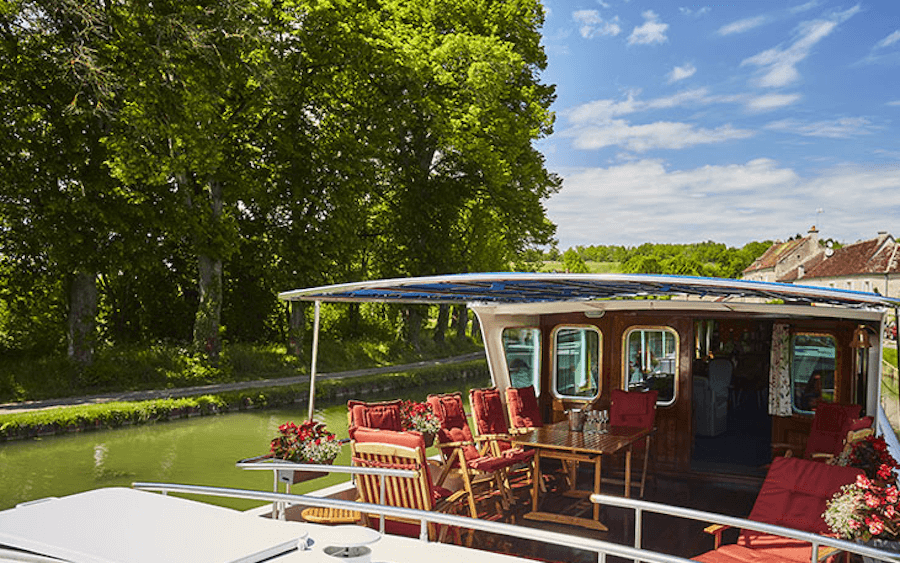
But history runs deep here: this canal was a strategic front during World War I, and nearby memorials, trenches, and museums tell powerful stories of resilience. Cycling opportunities are surprisingly plentiful along the region’s canals as well, often taking those who wish to explore France on two wheels whizzing past vast vineyards and verdant woodlands. Cruising in Champagne leads to a leisurely journey where every glass, every adventure, and every mooring has an extraordinary story to tell.
Today, thanks to the massive restoration projects, the Canal de l’Aisne à la Marne offers a beautiful cruise route for pleasure craft and hotel barges. Guests in the region feast on Chaource, a soft, creamy cheese that pairs beautifully with Champagne wines, while gourmet Chocolatiers have developed refined confections perfect to enjoy with a flute of bubbly.
The towpaths along the canal have been converted into dedicated cycling paths, making it a popular choice for those who wish to “work off” the region’s many gourmet indulgences.
Canal de l’Aisne à la Marne: Caveats
While this canal offers a rich blend of sparkling wine and military history, it’s less traveled than others, meaning fewer boats and a quieter atmosphere, but also more limited infrastructure in some areas. Certain sections can be narrow or overgrown, especially early or late in the season, and mooring options may be more agrarian than urbane. For guests seeking Champagne’s quieter corners and don’t mind a rustic touch, this region is a hidden gem.
Hub City for Canal de l’Aisne à la Marne Cruises: Paris
With Champagne’s appealing proximity to the City of Light, Paris is the hub city for the barges along this route.
Cheers to the Canal de l’Aisne à la Marne!
RELATED: Check out the barge cruises QuirkyCruise has personally reviewed, HERE.
Hope You Enjoyed This Visit to the Best Canals in France for Barge Cruising!
Drop us a line below if you have any questions and we can help you figure out which barge is best for you!
The QuirkyCruise team has personally sampled more than a dozen barge cruises and our friends at Barge Lady Cruises have cruised on many dozens of barges in France and are a font of knowledge.
Interested in a Barge Cruise in France?
Family-owned Barge Lady Cruises is an expert in barge cruising in France. The specialist travel agency was founded in 1985 and the Barge Lady team has sampled hundreds of barges over the years.
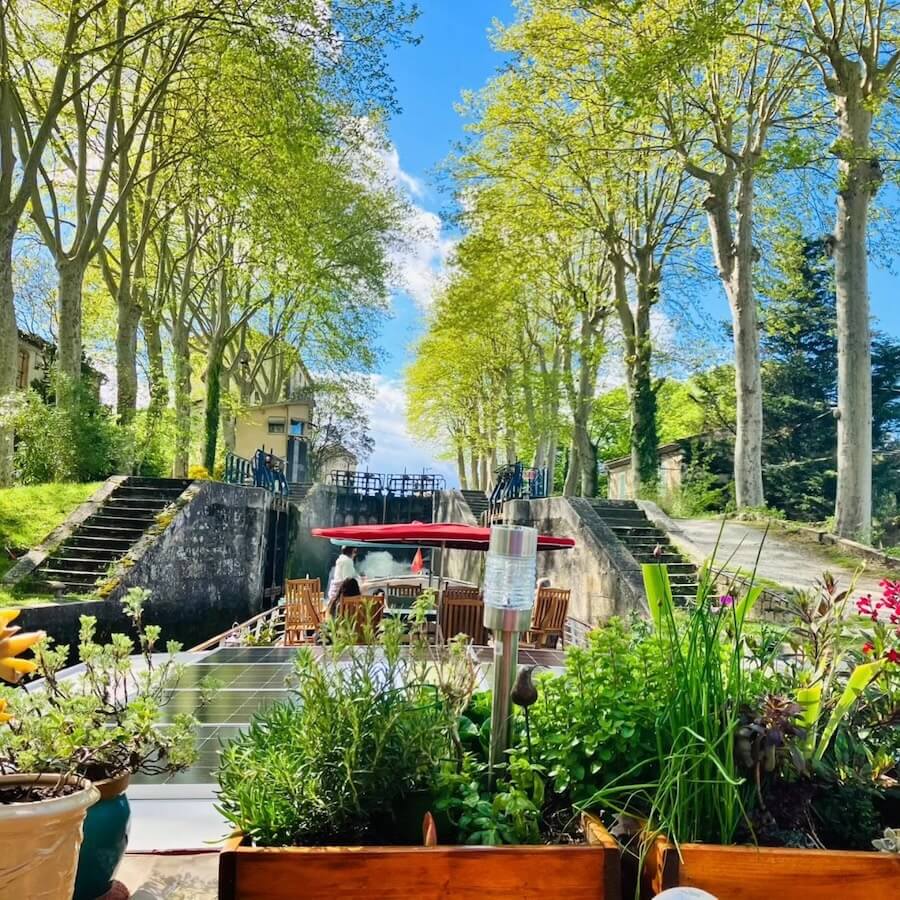
Barge Lady Cruises can help you choose the best canal barge cruise for your next dream vacation. Remember, barge cruises are super convenient; you won’t have to lift a finger! Pricing is all-inclusive, covering all meals, wine and spirits, guided excursions and entry fees, and transfers to/from a central point (ie often Paris).
To show your interest in a 6-night barge cruise offered by Barge Lady Cruises, please tell us a bit more about what you’re looking for and we’ll be happy to get back to you right away.
* Your personal information will be used solely for purposes of responding to your request.
Stephanie Sack has sampled more than 25 French barge cruises along eight inland waterways, and when traveling in Europe loves to improve her conversationally fluent French. For the past 11 years, she’s also been a crucial cog in the family-owned Barge Lady Cruises team, a specialist travel agency cruises founded by her mother Ellen in 1985. Her favorite French barge cruise? ALL OF THEM!


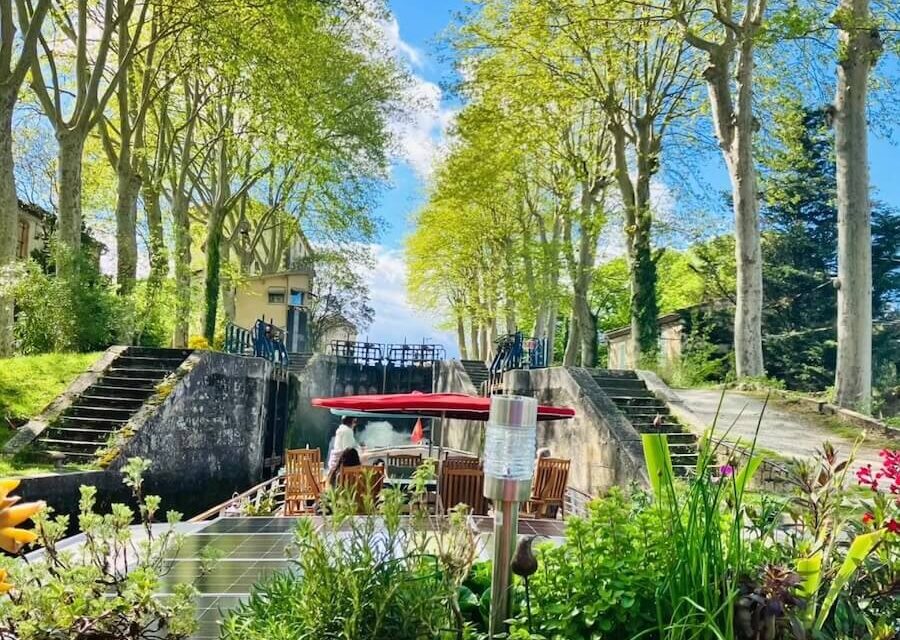
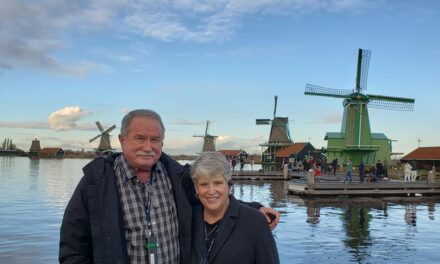




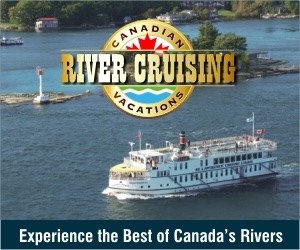

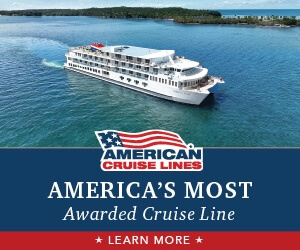




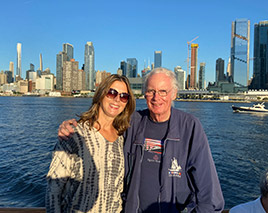 HEIDI SARNA
HEIDI SARNA
